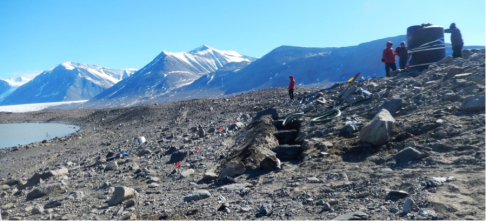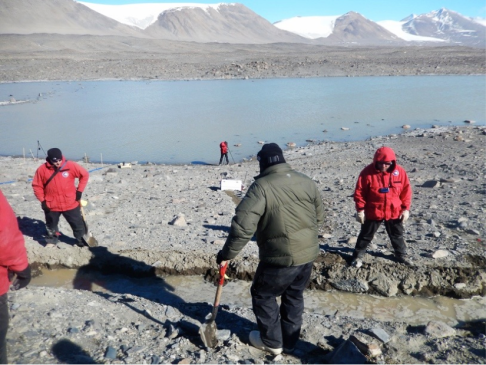It’s time for an update on our recent activities at Many Glaciers Pond, the site where we are running the Pulse and Press Project (P3). To recap, this experiment was designed to simulate permafrost (subsurface) melt and subsequent transport of water across the landscape. We will measure what happens to soil chemistry (moisture, salinity etc.) and how the resident animal communities respond to these changes. The soil sampling went smoothly, adding to two previous years of pre treatment data, and while we were extracting and counting nematodes in the lab the final preparations for the watering were being made in the field.
Trenches were dug above the experimental plots to contain the water treatment. A 500 gallon tank was sling-loaded beneath a helicopter and transported to the site, along with other plumbing apparatus and equipment. After 3 years of planning, discussion, debate and speculation it was time to see if this would actually work…
Would the water just sit there, contained in the trench and freeze in place?
Would it erode the trench banks and flow over the surface?
Or would it flow down the hill, over the permafrost layer but beneath the surface, altering moisture content and transporting solutes?
All of this was going through our heads as the first water was pumped into the trenches.
At first the water disappeared quickly, and aside from some minor breaches of the trench walls, the experiment appeared to be working as expected. As more and more water was applied, the draining rate slowed, but still continued through the day. Thermal imaging and sensors for the soils were used to track the movement of water throughout the landscape. More details on this to follow! After two days, 200 gallons had been applied to the experimental plots and we “Wormherders” were a happy group of scientists.






5 comments
Comments feed for this article
February 1, 2014 at 2:15 am
Mike Burris
Hello my name is Mike Burris. I am an agronomIst I agree with you mankind is about to destroy the soil health . It has a lot more to do with soil tillage and using g mo crops than climate change.
thank you.
February 4, 2014 at 6:12 pm
Kenzie Campbell
Hi my name is Kenzie Campbell. This seems like a wonderful group or researchers doing great work for the environment. Im a 19 year old in college and was wondering if its possible to become part of this research team? Currently Im a environmental engineer major. However, I think if given an opportunity with your team I would most likely become a soil scientist.
January 7, 2015 at 8:46 am
THE P3 EXPERIMENT | The World of Nematodes
[…] Our first priority this season is the sampling and treatment of the Pulse and Press Project (P3). This experiment has been running for three years already, and this will be the first sampling opportunity after treatments have been applied. To briefly summarize, this work investigates the effect of increased subsurface water flow on soil biota and other soil parameters. Last year we collected a third year of baseline data and were interested in the logistics of how best to apply the water in a controlled way. This involved pumping water uphill from a nearby pond and into a holding tank, where it was sterilized and applied back down slope to the plots. https://nemablog.wordpress.com/2014/01/14/p3-a-success/ […]
January 29, 2016 at 5:30 am
Summary of a successful field season | The World of Nematodes
[…] our core experiments and long-term study sites. These included the Stoichiometry Experiment, the P3, the Elevational Transects (read about these here or here), the LTM, and the controls from the BEE […]
May 16, 2017 at 6:47 am
Jodi
Have your self a nice rant there homie? You repeated yourself on every sentence except the first. Also you are a HUGE hypocrite. I’d have to say that your dumb already, so yeah please save your last brain cell: quit all drugs, even your “O of dr;”o. Do the world a favor and disconnect your Internet. Save your money and leave us alone